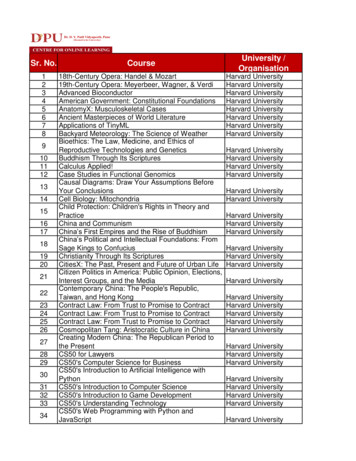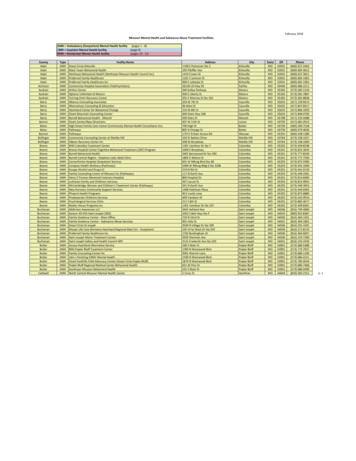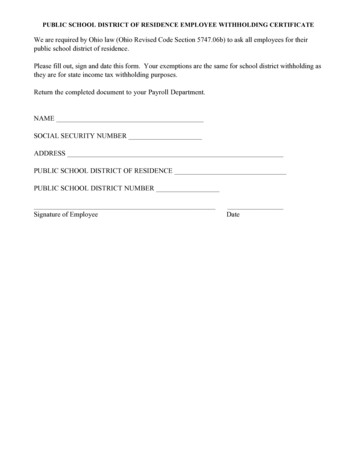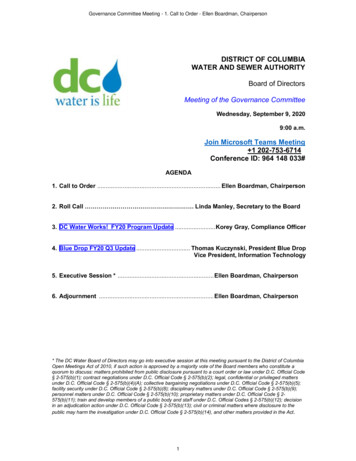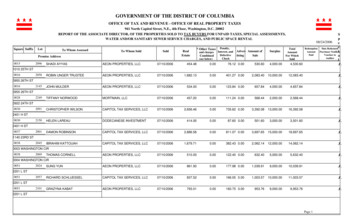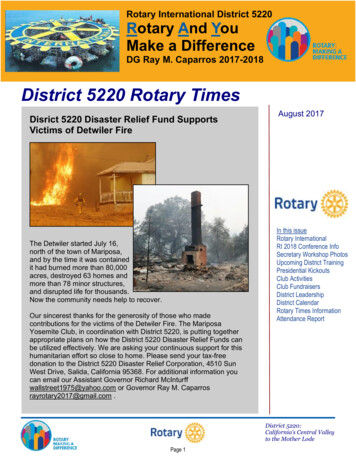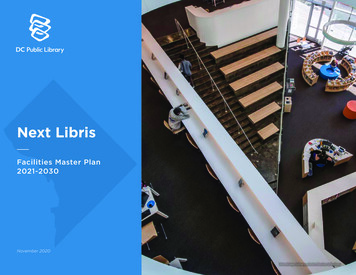
Transcription
Next LibrisFacilities Master Plan2021-2030November 2020Woodridge Library, photo: Maxine Schnitzer
“The future isalready here—it’s just not veryevenly distributed.”WILLIAM GIBSON 12DC P U B L I C L I B R A RYShaw Library, photos: Paul Rivera
ContentsForeword5Introduction7Background11Analysis & Findings19Recommendations39Next Libris: Facilities Master Plan 2021-20303
DC Public LibraryBoard of TrusteesGregory M. McCarthy, PresidentKarma Cottman, Vice PresidentShanel O. AnthonyLeif A. DormsjoMonte MonashVictor A. ReinosoAntonio (Tony) WilliamsC. Brian WilliamsRichard Reyes-Gavilan, Executive Director4D C P U B L I C L I B R A RYCapitol View Library, photo: Maxine Schnitzer
ForewordAnacostia LibraryA half-billion dollars. Over the past decade, this is how muchthe District of Columbia has invested in new and modernizedlibraries across all eight wards. Beautiful, award-winning, lovedand well-used libraries now pepper the District and are theenvy of cities nationally.Our 25 neighborhood libraries collectivelysee four million visits per year andwe expect that number to eventuallyincrease, especially after this year’s highlyanticipated reopening of the flagshipMartin Luther King Jr. Memorial Library.If the libraries are new, loved and wellused, one might ask why the DC PublicLibrary is now publishing a facilities masterplan. Isn’t the library system more or lessfinished with its building projects? Theanswer to that question is an emphatic“no” for three important reasons.First and perhaps most fundamentally,the Library must maintain and protect itsnew buildings for the use and enjoymentof generations to come, never allowingthem to fall into disrepair. This facilitiesplan includes a comprehensive facilitiescondition assessment that allows for theLibrary to better plan and budget formajor infrastructure projects like HVACand elevator replacements. This will keepour buildings looking and running betterlonger, and help protect the significantinvestments residents have made intheir library system.Next, public libraries continue to evolveat a pace that requires a near constantevaluation and rethinking of how theirinterior spaces meet user demand. In2017, the Library published a strategicplan in which it committed to tailor libraryservices to community needs. Most of theneighborhood libraries designed prior to2014 had a similar service model in mind,regardless of the community each buildingwas designed to serve. Today, we have amore nuanced understanding of how ourlibrary buildings are used and know thattechnology and changing user behaviorshave disrupted the library industry inexciting and unexpected ways. In additionto serving as a traditional repository forbooks, among many other functions, ourbuildings serve as co-working spacesfor the self-employed, laboratories fortechnological exploration, play spaces forinfants and toddlers, and safe spaces forour most vulnerable residents.Next Libris: Facilities Master Plan 2021-20305
We have titled ourfacilities plan Next Libris,a play on the Latin termex libris (meaning “fromthe books”). We think thetitle conveys the intrigue,energy and excitementabout the future of books,learning and libraries.The facilities plan will ensure our buildingsremain responsive to the services residentsdemand from their libraries.Third and closely related to the notionof the evolution of public libraries is theevolution of the District of Columbia itself.With more than 700,000 residents, theDistrict continues to grow and changeand the facilities plan provides a strategyfor addressing library service gaps thatexist in the city. Of particular importancehere is the concept of equity and a fullerunderstanding of the barriers that someresidents face in accessing library services.What role can a reimagined library campusplay in removing barriers to participationwith libraries and all the resources andopportunities contained therein?We have titled our facilities plan NextLibris, a play on the Latin term ex libris(meaning “from the books”). We thinkthe title conveys the intrigue, energy andexcitement about the future of books,learning, and libraries. Our hope is toinitiate an important dialogue with thecity’s elected officials and stakeholdersabout the continued evolution of ourlibrary system and the resourcesnecessary to accomplish these goals.6D C P UB L I C L I B R ARYWe are confident that continuing to investin public libraries, even among compellingmunicipal priorities that are compoundedby the COVID-19 recovery efforts, willcomplement numerous other educational,community building and public safetyaspirations. In a city managing fast-pacedchange, our neighborhood libraries are aforce to bind together all eight wards. Wewould like to thank all the District residentsand staff members who participated in theprocess. We are excited to share this plan,and we look forward to working with youall on charting a bold path for the nextdecade of library services in the District.Sincerely,Gregory M. McCarthyPresidentDC Public Library Board of TrusteesRichard Reyes-GavilanExecutive DirectorDC Public Library
IntroductionWest End LibraryThe District of Columbia Public Library is a vital learninginstitution committed to supporting the needs of allresidents regardless of where they live, their income oreducational attainment.With 26 locations, including a centrallibrary and a robust online presence, theDC Public Library is one of the busiestlibrary systems in the country, boastingalmost four million library visits each year.Next Libris, the DC Public Library’sFacilities Master Plan, articulates theLibrary’s commitment to not only maintainthe city’s public libraries, but to adaptthem for new uses and continue to pursuestrategic opportunities to grow andgive even more residents access to thisincreasingly vital engine of communitylife. The Plan comes as the Library nearscompletion of a 10-year transformation inwhich 24 of 26 libraries will be new or fullymodernized by 2024, including the MartinLuther King Jr. Memorial Library, theDistrict’s central library.DC Public Library developed the FacilitiesMaster Plan to help guide its physicalservice delivery strategy for the next 10years and beyond. It is aspirational andproposes that in the future, the Library willneed to and should serve more residents,more equitably, than it does today. TheLibrary will accomplish this by tailoringlibraries to respond to individual communityneeds and by growing the system to meetthe needs of an expanding city.The Plan contains high-level analyses,findings and recommendations thatposition the Library to address broaderDistrict-level issues. It provides a close lookat existing library buildings, communityneeds and opportunities for better accessto library services.Future neighborhood and site-level studiesas well as community engagement will berequired to determine project feasibility,identify specific sites as needed, developdetailed scopes of work and define precisebudgets and schedules.Next Libris is a living document thatwill be updated as new informationbecomes available, enabling the Libraryto respond to changing circumstancesand opportunities. The plan was developedprior to the COVID-19 outbreak, whichwe know may have profound long-termimpacts on city services.Next Libris: Facilities Master Plan 2021-20307
Next Libris articulates theLibrary’s commitment tonot only maintain the city’spublic libraries, but toadapt them for new usesand continue to pursuestrategic opportunities togrow and give even moreresidents access to thisincreasingly vital engineof community life.While the plan is intended to inform the Library’s annual budget request, it is not afinancial plan nor a commitment by the Library or District to any specific project orother individual recommendation. Further formal action by the Library Board ofTrustees, Mayor and Council of the District of Columbia will be required to implementany recommendations.The Facilities Master Planning GoalsThis Facilities Master Plan has three goals. These goals collectively frame the Library’sdecision-making philosophy for investments over the next decade. Drafted with Librarystaff and later refined through a robust community engagement process, the goals areas follows:Manage assets wiselyThe Library will be agood steward of existingfacilities by proactivelymaintaining agingbuilding systems.Grow smartly andequitablyDesign and buildresponsivelyThe Library will seekways to provide moreequitable services tomore residents acrossthe District of Columbia.The Library will regularlyupdate building interiorsto remain responsive toneighborhood needs.Central to each of these goals is the need to consider prioritization and timing. TheLibrary will prioritize projects that address needs identified in this plan and will timethem in such a way that is realistic and within its existing budget authority.8D C P U B L I C L I B R A RY
The Planning ProcessThe master planning process centered on developing a better understanding of theDistrict of Columbia’s changing demographics and what those changes might meanfor library services, in addition to developing a detailed understanding of the Library’sexisting buildings.The Library reviewed background information, collected and analyzed data andengaged with stakeholders and the community to get a fresh look at how well theexisting footprint is meeting community needs. This approach informed a set ofcomprehensive findings and recommendations that position the Library to betterserve residents.Equity Impact StatementDC Public Library is committed to the elimination of racial, social andphysical barriers and biases that unjustly exclude residents from fullparticipation with its buildings, programs, books and services.Historically, the placement, size and program of public libraries have notalways factored in the needs of all residents nor considered the many andoften undercounted ways that residents use public libraries.Next Libris seeks to expand access to libraries in an inclusive mannerthat values the diversity of all members of our community. Individualrecommendations contained herein will be further scrutinized to ensurethere are no unanticipated adverse impacts to our community members.Furthermore, the Library will commit to being a leader in accessible designto promote full participation in and enjoyment of its facilities and resources.Next Libris: Facilities Master Plan 2021-20309Benning Library, photo: Davis Brody Bond
10D C P U B L I C L I B R ARYTenley-Friendship Library, photo: Mark Herboth
BackgroundSoutheast LibraryThe ways in which individuals access books and informationhave changed drastically in the past decade and publiclibraries are challenged to anticipate what comes next, adapt toevolving customer expectations, rethink service strategies anddeliver relevant services to a complex citizenry. 2The Library must have a strong understanding of the District’s changing landscapeand recognize how public libraries can position themselves in times of change. At thestart of the facilities master planning process, the Library reflected on how residents’evolving needs influence services in a changing city.Key demographic trends areshaping the District, and as acommunity learning hub, the Librarywill evolve to meet the needs of itsresidents. These factors—outlinedon the following page—will helpguide the Library leadership inimplementing the recommendationslaid out in this Plan.Next Libris: Facilities Master Plan 2021-203011
DEMOGRAPHIC TRENDSThe District has grown.Population growthmeans increased demandfor library services.Currently at approximately702,000 residents, thecity has added more than100,000 residents since thelibrary building renaissancebegan in 2010. 3 While theaftermath of the COVID-19pandemic may requireadjustments to projectionsof future growth, the cityis currently undergoing ademographic shift as bothdomestic migration andinternational immigrationbring new populations to theDistrict.4 As D.C.’s populationhas grown, additional libraryservices and spaces areneeded. Additionally, existinglibrary locations will needto be reconfigured to servechanging neighborhoods.12D C P U B L I C L I B R ARYD.C. is getting younger.Young people needlibraries to succeed.Public libraries are a vitalresource for children andteens, providing free andsafe spaces that offeropportunities to growintellectually, emotionallyand socially.Young people are drawnto libraries to access theInternet, study, read, write,socialize and participate inprogramming or just tohang out. 5The District’s wealthand educationalattainment is unevenlydistributed.D.C.’s non-Englishspeaking populationis growing.Libraries build resilientcommunities andprovide economicopportunity.Libraries providelanguage andliteracy services.The District’s medianincome continues to rise,but income gains areunevenly distributed acrossthe city. Higher levels ofwealth and educationalattainment are concentratedin the Northwest quadrantof the city; Wards 7 and 8lag significantly behind inboth categories.6While the borrowing ofbooks in Ward 7 and 8libraries is less than in otherparts of the city, demand forother library services, suchas technology and meetingroom access, is greater.More than 25 percent ofresidents in the Washingtonmetropolitan area speaka language other thanEnglish at home.7Public libraries provideimportant resources forthose with language accessneeds and can tailor selectservices and programsfor non-native speakers.Libraries help immigrantsacclimate to American life bywelcoming, supporting andintegrating new residentsfrom all over the world. 8
E-books vs. Print BooksElectronic books andincreased use of online holdsfor print books offer newopportunities forlibrary space planning.Throughout the extensivecommunity engagement processthat informed Next Libris, residentsstressed repeatedly that books arestill important and remain a primaryand fundamental reason for theiruse of the library system.The way in which residentsare currently accessing their readingmaterial suggests that the Libraryrethink the amount of shelf spacedevoted to books and considerreducing it in favor of other pressingcommunity needs such as studyrooms or programming space.DC Public Library tracks the circulation of library materials by format and the trend is clear.E-books are becoming increasingly popular among library users. From 2014-2019, increasesin the overall circulation of library books has been due almost entirely to increases in thecirculation of e-books (digital circulation). A word of caution: while many residents enjoythe convenience of direct-to-device delivery of books, other residents, especially in lowincome areas of the city, may not have the same level of access to electronic content.Another concern is the tenuous relationship that currently exists between libraries andmajor publishers with regard to access to e-books. As major e-book publishers, in an effortto increase consumer sales, continue to explore options to limit public library access toe-books, the future of e-books in libraries will remain uncertain.CIRCULATION TRENDSPhysical CirculationDigital Circulation1,000,000800,000ITEMS CIRCULATEDHow the District reads andaccesses library books israpidly 2019Next Libris: Facilities Master Plan 2021-2030202013
We are seeing that libraryusers are spending lesstime browsing libraryshelves for somethinggood to read and insteadare going to the Library’sonline catalog, identifyingthe books they want andplacing a hold on the titleto be picked up at theneighborhood library oftheir choice.Placing Holds vs. Browsing the ShelvesLibrary users in Washington, D.C., like consumers everywhere, are becoming morecomfortable with online browsing for physical items. Rather than going to a shoe storeto browse for shoes, consumers are going to online sites, finding the shoes they want,then having them delivered to their homes. Similarly, we are seeing that library usersare spending less time browsing library shelves for something good to read and insteadare going to the Library’s online catalog, identifying the books they want and placing ahold on the title to be picked up at the neighborhood library of their choice. The chartbelow illustrates this remarkable change in library user behavior. From 2013 to 2019,the percentage of customers who use the holds system jumped from 37 to 50 percent.In addition, checkouts by these customers jumped from 60 to 70 percent in that sametime period. If the trend continues, the implication for library interior space planningis profound. If readers are spending less time browsing shelves, then libraries shouldconsider devoting less space for shelving. The library system can leverage the generousamount of shelving at the new central library and have that building serve as thedistribution hub for books being requested at libraries throughout the city.LENDING ACTIVITY BY YEARPercent of checkouts by holds system customersPercent of lending customers who use holds system80%70%60%50%40%30%14D C P UB L I C L I B RARY2013201420152016201720182019
What does DC Public Library looklike today?The DC Public Library is a system of 26libraries with space totaling 900,000square feet. Of the 26 buildings, 21 are newor fully modernized and three more are inthe planning, design or construction phaseincluding the central Martin Luther KingJr. Memorial Library. The modernizationof the Library’s buildings over the pastdecade represents an extraordinary paceof project delivery across every ward ofthe District.MAP OF LIBRARIES TODAYModernized or New ConstructionShepherd ParkTakoma ParkNot ModernizedWard 4ChevyChasePetworthTenleyFriendshipWard 3Ward 5Mt. PleasantClevelandParkPalisadesGeorgetownWard 1ShawDeanwoodANNUAL GATECOUNT446KTOTAL ACTIVEACCOUNTSNortheastWard 24.9MBenningCapitol ViewWard 6Ward AnacostiaParklandsTurner24KMEETING ROOMRESERVATIONSRosedaleNorthwest OneMLK Central3.8MSmall NeighborhoodLibrariesWoodridgeWest End2019 STATISTICSCurrently in Design orConstructionLamondRiggsWard 8Bellevue944KCOMPUTERSESSIONSNext Libris: Facilities Master Plan 2021-203015
What investments have beenmade in DC Public Librarybuildings?DC Public Library’s award-winningprojects have advanced designexcellence and sustainability. Newbuildings, coupled with expandedprograms, have raised the bar for whatD.C. residents expect in their libraries.Through the Facilities Master Plan, theLibrary now better understands whatinvestments are needed to keep thesebuildings in good working condition andhow it can continue the modernizationprogram in a strategic manner.Most of the District’s public librariesoffer a full range of programs andservices in 15,000 to 20,000 square feetof space. These full-service libraries offerdedicated space for children, teens andadults, and include meeting rooms, studyrooms, program spaces and shelvingcapacity for tens of thousands of books.Most of these libraries offer services ontwo or three floors and are large enoughto meet community demand.16D C P UB L I C L I B RARYTIMELINE OF WORK COMPLETEDNew ConstructionModernizationLeased StorefrontLibraries build resilientcommunities and provideeconomic opportunity.The District’s median incomeNorthwest Onecontinues to rise, but income gainsare unevenly Parklands-Turnerdistributed acrossthe city. Higher levels of wealthTakomaPark (Phase1)and educationalattainmentareconcentrated in the Northwestquadrant of the city, while Wards 7and 8 lag significantly behind in bothcategories. While the borrowing of200920102011books in Wards 7 and 8 libraries isless than in other parts of the city,demand for other library services,Anacostiasuch as technology and meetingroom access, is far greater.BenningPetworthTenley-Friendship(Dorothy I. Height)DeanwoodGeorgetownShaw(Watha. T. Daniel)Bellevue Library, photo: Maxine Schnitzer20122013Bellevue(William O. Lockridge)Francis A. GregoryMt. PleasantRosedale
WoodridgeCleveland ParkMartin Luther King Jr.Memorial (Central)Palisades2014201520162017201820192020In ProgressLamond-RiggsSoutheastSouthwestCapitol ViewNortheastWest EndTakoma Park (Phase 2)Next Libris: Facilities Master Plan 2021-203017
Small Neighborhood LibrariesParklands-Turner Library, photo: Mary ParkerThe library system’sofferings have increaseddramatically over thepast decade and thesesmall libraries cannotbegin to offer the fullrange of services that thelarger buildings provide.In the late 1970s, four library kioskswere built to serve neighborhoods thatlacked library service. These plexiglassand-metal booths were less than 1,400square feet in size. They had limited hours,small collections of library materials andlacked space for technology, meetings orprogramming. While they were intendedto last no more than seven years, theyremained open for three decades.As part of the library constructionrenaissance that began in 2009, thekiosks were replaced by smallneighborhood libraries, most of whichare co-located with city recreationcenters (Northwest One and Rosedalein Ward 6, Deanwood in Ward 7 andParklands-Turner, a leased storefront, inWard 8). These libraries average 5,700square feet in size and are improvementsover the kiosks they replaced.However, the library system’s offeringshave increased dramatically over the pastdecade and these small libraries cannotbegin to offer the full range of servicesthat the larger buildings provide.18D C P UB L I C L I B RARYThey lack meeting rooms, program space,or study rooms and offer limited accessto technology and collections. The smallfootprints make it difficult to provideseparation between age groups, a sourceof frustration for customers.When we engage with communities todesign new libraries, the above-mentionedfeatures and services are exactly whatresidents request and prioritize. While abusy and full-service library can welcomemore than 200,000 visits annually, a smalllibrary typically serves fewer than halfthat number.As DC Public Library looks to expandservices across the city more equitably,it bears noting that the system’s smallestlibraries serve predominantly low-incomecommunities. An intentional commitmentto equity demands exploring opportunitiesto increase the Library’s footprint in theseareas of the city.
Analysis & FindingsCleveland Park Library, photo: Joseph RomeoThe Library used a multi-faceted approach to develop theFacilities Master Plan, organized around three key activitiesthat ultimately informed the recommendations that follow inthe next section.Facility ConditionAssessmentand FunctionalAssessmentStaff andCommunityEngagementLibrary Usage andPotential UsageAssessmentNext Libris: Facilities Master Plan 2021-203019
Facility Condition Assessment and Functional AssessmentThe Library conducted an exhaustiveFacility Condition Assessment (FCA) toevaluate and document the condition of itsbuildings and component parts. All facilitiesmanaged by the Library and not currentlyin design or construction were assessed.Of the 25 branch locations, 21 wereevaluated during this process. A teamof engineers walked buildings anddocumented the make, model andcondition of key building componentssuch as mechanical, electrical, plumbing,roofing, life safety, structural and heating,ventilation and air conditioning systems.SAMPLE FACILITY CONDITION ASSESSMENTS20D C P U B L I C L I B R ARYThe information gathered was compiledinto a database detailing the age andcondition of systems and components, arecommended timeline for maintenanceand replacement and cost estimationfor the work. This system will enable theLibrary to remain good stewards of existingassets by planning and budgeting formaintenance of its buildings.In addition, the Library conductedFunctional Assessments of five libraries9that first opened in 2010 and 2011.The objective of these assessments wasto determine how well the building designis serving community needs and whetherupdates are required.The functional assessments took intoaccount neighborhood level usageand demographic data as well as staffand community input. The goal is toidentify opportunities to remain responsiveto each neighborhood’s unique andchanging needs.
FINDINGSFacility Condition Assessment and Functional AssessmentOverall, DC Public Library’s buildingsare in good physical condition.The Library’s facilities are aging asanticipated – buildings that wereconstructed or modernized from 20092015 will require systems renewal projectsin the next five years. Those that wereconstructed more recently have additionalyears of useful life remaining.Designs age just asbuildings systems do.The Functional Assessmentsconducted in five libraries indicatethat building interiors need tobe updated as neighborhoodschange. Each of the five buildingsthat were studied showed signs offunctional obsolescence.Small capital projects are needed tokeep libraries in working order.The Library now has aMost major building systems requirereplacement after 15 to 20 years of service,based on average building use. Somesystems will retire more quickly, dependingon building wear and tear. As the averageage of buildings in the Library’s portfolionears 10 years, most libraries will requiresome level of major systems work in thenext decade.strong asset database.A key piece of the assessment was thecollection of component-level data. Bycataloguing each piece of equipment withinbuildings and adding the information intoa database, the Library can continue torefresh data through regular building walks.Using up-to-date information allows theLibrary to forecast maintenance needsand ensure building systems operateas efficiently as possible. This data alsoensures that recent facility investments aremaintained to the highest quality.SAMPLE FUNCTIONAL ASSESSMENTSNext Libris: Facilities Master Plan 2021-203021
Staff and Community EngagementThe engagement effort for Next Librisincluded focus groups, staff workshops,community meetings, a survey and apublic email address for residents tosubmit open-ended comments.More than 3,000 community commentswere synthesized to identify overallthemes for the future use of libraryfacilities. This process guided theidentification of specific priorities for theLibrary over the next 10 years.A copy of the community meetingpresentations and summaries offeedback received during eachengagement activity can be foundas an appendix to this report.DECEMBER 2018FEBRUARY 2019MARCH-APRIL 2019JUNE 2019835260100 7530FOCUS GROUPSPARTICIPANTSSTAFF TINGSPARTICIPANTSPARTICIPANTS1,200 COMMUNITY SURVEYRESPONDENTS28OUT OF 30RESIDENTIAL ZIPCODES REPRESENTEDOVER3,000COMMENTS22D C P UB L I C L I B RARY
FINDINGSStaff and Community EngagementThe community views the Library asa vital asset, one which they expectto grow and expand along with thecommunity’s changing needs.Library staff know their customers.Providing staff with access to additionalinformation can help them further tailorservices and attract new customers.Though by no means exhaustive, thebroad themes for future library serviceslisted below represent the main areas ofcommunity feedback provided during theengagement process.The Library engaged with staff fromacross the system to analyze and interpretdata during a series of staff workshops.More than 100 staff members participated,providing insight into how each libraryis currently used and what staff see asopportunities to tailor services to thecommunities they serve. Provide greater access to technology Provide community meeting spaceand serve as a civic convener Support children and families Empower hobbyists and lifelonglearners Connect residents with partnerorganizations and other services Equip job-seekers and entrepreneurs;support career developmentIt is impossible to provide the full rangeof library services in small libraries.Staff provided compelling insights into thelimitations in services and programmingthat exist at small libraries as comparedto that of a typical neighborhood library,often three times larger.“One manager said that amajor challenge aboutproviding library services insmaller locations is that bytrying to make the limitedspace work for everyonewalking in the door, you canend up feeling you aren’tproperly serving anyone.”– DC PUBLIC LIBRARY BRANCH MANAGERNext Libris: Facilities Master Plan 2021-203023
FINDINGSStaff and Community EngagementWhat did the Library hear?Focus Groups: The Library conducted eight focus groups with a range of audiences including current library customers, residentswho do not currently use the library, Spanish-speaking residents, teens and others who may face barriers to accessing libraryservices. From these conversations, the following themes emerged: Expand technology-based resources and servicesProvide educational, career and life skills trainingsServe as a one-stop shop for government and community servicesBooks are still importantCommunity Survey: The Library conducted a survey to gain more in-depth insight into what residents want from their public library.More than 1,200 residents responded to the survey, representing 28 of the 30 residential zip codes across the city.Responses revealed the following trends: Most satisfied with: Library overall, staff courtesy, hours of operation, safety/security and materials available for checkout Least satisfied with: Long waitlist for new titles and the Library website Top things not used or not familiar with: Downloadable or streaming materials; Wi-Fi; meeting room availability; computer,software and technology availability/features Reasons for not using the library more frequently: Lack of convenience, lack of time, use home internet for accessing informationCommunity Meetings: The Library hosted seven meetings across the city to share the planning goals and hear what servicesresidents want from their library. Feedback fell into
Victor A. Reinoso Antonio (Tony) Williams C. Brian Williams Richard Reyes-Gavilan, Executive Director 4 DC PUBLIC LIBRARY. . participation with its buildings, programs, books and services. Historically, the

